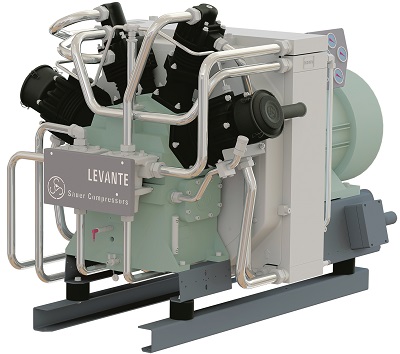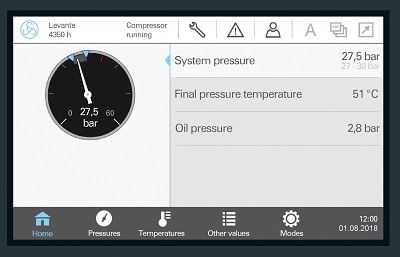Many engineers are familiar with plant compressed-air networks that pipe high-pressure air to pneumatic tools, industrial robots and countless types of production and packaging equipment. Perhaps not as widely known, but equally as important, compressed air also handles critical tasks on large commercial ships.

The three-stage Levante WP460L starting-air compressor has a capacity of up to 460 m³/hr at a pressure of 30 bar.
Compressed air is used onboard in a number of ways. One is for starting the main engines, auxiliary engines and the emergency fire pump. It is also used for propulsion automation and control. On deck, working air is essential, as pneumatic tools are often used for pressurized cleaning and maintenance jobs like drilling, chipping, sanding and buffing, as well as spray painting. Compressed air is also used for a ship’s whistle and fog horn.
At this year’s SMM maritime trade fair in Hamburg, Germany, Sauer Compressors, with U.S. headquarters in Stevensville, Maryland, will display a range of compressors suited for marine applications, as well as related controls.
Starting-air compressors. Sauer Compressors’ latest machine developed for commercial shipping applications is the Levante series. This three-stage, 3 or 4-cylinder air-cooled compressor runs at speeds of up to 1,780 rpm and has a capacity of up to 460 m³/hr at pressures to 30 bar. Its robust and compact construction, according to company officials, lets the low-maintenance compressor readily fit into an engine room while conserving valuable mounting space. To improve intercooling efficiency, air flow has been optimized by installing a newly developed cube-cooler between the motor and compressor—reducing recooling temperatures by one-third. The Levante also comes with an integrated gauge panel and an operator-friendly HMI.
Air-cooled. Similar to the Levante series, the three-stage air-cooled Passat range features a durable design to handle demanding operating conditions. Its three cylinders are arranged in a W-shape to minimize vibrations, and the unit offers capacities of up to 270 m³/hr and maximum pressure is 40 bar.
Dividing the compression process into three stages notably decreases operating temperatures, said Sauer officials. This results in significant benefits over two-stage water-cooled units. Due to lower compression temperatures the lubrication oil will not experience thermal cracking and, consequently, deposit coke on compressor valves. Thus, Sauer compressors offer maintenance intervals of up to 4,000 hr, significantly longer compared to two-stage water-cooled machines. It also permits the use of standard mineral oil, rather than expensive synthetic oil. In addition, eliminating the cooling water circuit, pumps, piping and controls leads to less maintenance and higher reliability.

The new MLC 4.0 control readily integrates into high-level control systems and meets the connectivity demands of tomorrow’s vessels.
New generation controls. The new MLC 4.0 presents a new high-end addition to Sauer Compressors’ range of controls. The unit has a 7-in. touchscreen and reportedly offers intuitive operation and provides excellent usability. It handles automatic compressor control, monitoring and protection of compressor operations, and pre-programmed logic control for simple operation.
It offers an integrated lead/lag function for balancing running hours of up to eight compressors, and the robust design is suited for marine ambient conditions. A simple text and graphic display provides straightforward operation. Given its easy integration into higher-level systems, the new control enables the high connectivity required to meet the demands of tomorrow’s vessels and “Shipping 4.0.”
Oil-free applications. HAUG Sauer compressors include a wide range of hermetically gas-tight and oil-free compressors up to 30 kW. Due to this design, the compressors can be used to compress virtually any gas, including boil-off gas in shipping. Even in operations with long standstills, frequent interruptions and cold starts, these compressors are said to operate with maximum reliability.
Exhaust gas purification. Exhaust gas purification is crucial. To supply state-of-the-art SCR systems for the reduction of nitrogen oxides with compressed air, the new Sauer SC85 and SC99 screw compressors deliver a volume flow of up to 700 m³/hr with a maximum power of 99 kW.
Sauer Compressors USA
www.sauerusa.com
Filed Under: Pneumatic Tips